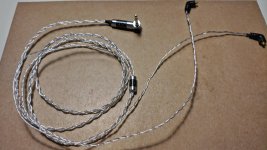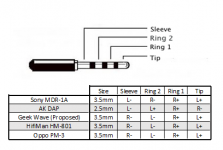So guys, I recently built a single-ended 3.5mm 4core cable for my CIEMs, with mmcx termination at the IEMs' side.

I intend to get a balanced source, and I would like to turn the cable to balanced 2.5mm. But I came across this picture:

Which termination should I choose? Which one is the most common? (The source will be the Zishan AK4497 DSD DAP)
And another thing: I can see adapters for balanced cables to single ended. What would the wiring of such an adapter be? L+ and R+ on tip and ring respectively, and the L- and R- together on the sleeve of a 3.5mm 3pole jack?
My goal is to turn the cable I built to balanced 2.5mm, and then make a 2.5mm balanced to 3.5mm single ended adapter.

I intend to get a balanced source, and I would like to turn the cable to balanced 2.5mm. But I came across this picture:

Which termination should I choose? Which one is the most common? (The source will be the Zishan AK4497 DSD DAP)
And another thing: I can see adapters for balanced cables to single ended. What would the wiring of such an adapter be? L+ and R+ on tip and ring respectively, and the L- and R- together on the sleeve of a 3.5mm 3pole jack?
My goal is to turn the cable I built to balanced 2.5mm, and then make a 2.5mm balanced to 3.5mm single ended adapter.
Last edited:
T,R1 should be pluses.
S,R2 minuses
anything else seems stupid, you must think backward compatibility..(unbal)
...smartphones use 4pin jack as hadsfree - there is microphone in it. in these cases it will be not compatible.
S,R2 minuses
anything else seems stupid, you must think backward compatibility..(unbal)
...smartphones use 4pin jack as hadsfree - there is microphone in it. in these cases it will be not compatible.
T,R1 should be pluses.
S,R2 minuses
anything else seems stupid, you must think backward compatibility..(unbal)
...smartphones use 4pin jack as hadsfree - there is microphone in it. in these cases it will be not compatible.
Hmm ok. So I guess tip L+, R1 R+, and then? Which minus should go where?
Yeah, the problem is that there aren't any specs regarding the wiring of the balanced output. Anyway, a person from another forum checked with a multimeter a cable that was confrimed to be working with the device, and the AK standard is the one I need. Thank you anyways.i dont know. you should follow player specs
The chart is correct, the most common being the Astell & Kern which is also used on Onkyo DP-X1 and other 2.5mm players like the Zishan.
Yeah, that seems to be the case. By any chance, do you know why the 4.4mm sony balanced standard (not incl. in the chart) has 5 poles instead of 4? What is the 5th pole used for? And does every device which has a 4.4 balanced output (for example: Hiby R6 Pro) follow the same Sony standard?The chart is correct, the most common being the Astell & Kern which is also used on Onkyo DP-X1 and other 2.5mm players like the Zishan.
Sony 4.4mm "Penta"
The sony 5 pole or "penta" connector is 4.4mm. This is a sort-of-new standard from JEITA, so yes all devices which use this connection should be compliant and have the same pinout. The 5th contact, the sleeve, is ground in case you need a ground connection.
Note there is no exposed ground on the 2.5mm and 3.5mm balanced connectors. In fact if you look closely at your 2.5mm balanced player you will see that the 2.5mm receptacle itself is insulated from the player chassis so as not to short the out of phase L signal to the chassis when the plug is inserted.
Yeah, that seems to be the case. By any chance, do you know why the 4.4mm sony balanced standard (not incl. in the chart) has 5 poles instead of 4? What is the 5th pole used for? And does every device which has a 4.4 balanced output (for example: Hiby R6 Pro) follow the same Sony standard?
The sony 5 pole or "penta" connector is 4.4mm. This is a sort-of-new standard from JEITA, so yes all devices which use this connection should be compliant and have the same pinout. The 5th contact, the sleeve, is ground in case you need a ground connection.
Note there is no exposed ground on the 2.5mm and 3.5mm balanced connectors. In fact if you look closely at your 2.5mm balanced player you will see that the 2.5mm receptacle itself is insulated from the player chassis so as not to short the out of phase L signal to the chassis when the plug is inserted.
Oh ok, thanks for the info. I can indeed see that all the ports are insulated from the case. But how does the ground help? What's the difference between the 2.5mm with the L+,L-,R+,R- and the 4.4 that has all this and a ground? Why the 4.4 needs a ground, and the 2.5 doesn't?(Sorry for the, probably dump question, but I don't have any knowledge about the reason behind this kind of things, I am fairly new to the diy audio world)The sony 5 pole or "penta" connector is 4.4mm. This is a sort-of-new standard from JEITA, so yes all devices which use this connection should be compliant and have the same pinout. The 5th contact, the sleeve, is ground in case you need a ground connection.
Note there is no exposed ground on the 2.5mm and 3.5mm balanced connectors. In fact if you look closely at your 2.5mm balanced player you will see that the 2.5mm receptacle itself is insulated from the player chassis so as not to short the out of phase L signal to the chassis when the plug is inserted.
Oh ok, thanks for the info. I can indeed see that all the ports are insulated from the case. But how does the ground help? What's the difference between the 2.5mm with the L+,L-,R+,R- and the 4.4 that has all this and a ground? Why the 4.4 needs a ground, and the 2.5 doesn't?(Sorry for the, probably dump question, but I don't have any knowledge about the reason behind this kind of things, I am fairly new to the diy audio world)
The ground is not necessary and indeed useless for driving headphones.
But suppose you wish to drive a preamplifier's balanced XLR inputs. The 3 pin XLRs in preamps have in phase (+), out of phase (-) and ground. So in theory you would utilize the ground for this type of connection. Its probably not strictly necessary, would still work with ground unconnected, but in the weird world of hum pickup, grounding, etc... its there if you need it.
Oh, yes, makes sense. One last thing. If I have an earphone with a 2.5mm balanced cable, and want to make an adapter to connect it to a 4.4 output, I guess, based on what you said, that I only need to connect the L+- and R+- of the 2.5 to the 4.4, and just leave the ground of the 4.4 plug disconnected, correct?The ground is not necessary and indeed useless for driving headphones.
But suppose you wish to drive a preamplifier's balanced XLR inputs. The 3 pin XLRs in preamps have in phase (+), out of phase (-) and ground. So in theory you would utilize the ground for this type of connection. Its probably not strictly necessary, would still work with ground unconnected, but in the weird world of hum pickup, grounding, etc... its there if you need it.
One more (bad) reason for having a ground - Suppose all you have is a balanced output, the ground lets you connect to an RCA plug input, L+/gnd and R+/gnd to RCA input. With no ground you have L+/L-/R+/R- there is no way to connect to an RCA without shorting something out. I say this is bad because every player will have an unbalanced output and because you really would not want to do this with other options available to you.
Correct.
Oh, yes, makes sense. One last thing. If I have an earphone with a 2.5mm balanced cable, and want to make an adapter to connect it to a 4.4 output, I guess, based on what you said, that I only need to connect the L+- and R+- of the 2.5 to the 4.4, and just leave the ground of the 4.4 plug disconnected, correct?
Correct.
It seems that I don't really understand how this works. In a balanced signal (let's say from a 2.5mm output) you have L+,L-,R+,R-. The RCA has 2 poles for L and 2 for R. How does the additional ground of the 4.4 help you connect the 4.4 to the RCA? Then you have 5 "poles" and an RCA cable has 4 in total.One more (bad) reason for having a ground - Suppose all you have is a balanced output, the ground lets you connect to an RCA plug input, L+/gnd and R+/gnd to RCA input. With no ground you have L+/L-/R+/R- there is no way to connect to an RCA without shorting something out. I say this is bad because every player will have an unbalanced output and because you really would not want to do this with other options available to you.
It seems that I don't really understand how this works. In a balanced signal (let's say from a 2.5mm output) you have L+,L-,R+,R-. The RCA has 2 poles for L and 2 for R. How does the additional ground of the 4.4 help you connect the 4.4 to the RCA? Then you have 5 "poles" and an RCA cable has 4 in total.
You think the RCA has two poles for each connector because they look like they do. But in reality the RCA shells are connected together to one another and also to ground. So whatever is connected to one shell on L is also connected to the other shell on R and is also connected to ground.
You may successfully connect L+ to RCA pin on L and R+ to RCA pin on R but what are you going to do with the shells? Any remaining connection you make is going to short out to ground unless you can use an exposed ground from your player.
Last edited:
Yeah, the rca shells (ground) are connected together. Like normal 3.5mm TRS cable of earphones. The ground is common for the 2 channels, and the signal is not. What I am not getting is where are the extra poles of the balanced go.You think the RCA has two poles for each connector because they look like they do. But in reality the RCA shells are connected together to one another and also to ground. So whatever is connected to one shell on L is also connected to the other shell on R and is also connected to ground.
Oh wait, now I saw the edit. And what happens to the L- and R- ? We get from the 4.4 balanced output an R+,R-,L+,L- and a GND. We connect the GND to the shells of the RCA cable, and L+ to L, R+ to R. What happens with the L-,R-?
Last edited:
- Status
- Not open for further replies.
- Home
- Amplifiers
- Headphone Systems
- Balanced and Single-ended cable